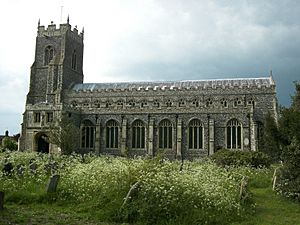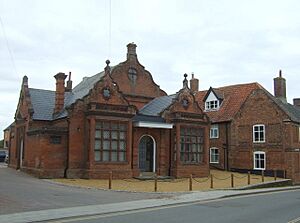Loddon, Norfolk facts for kids
Quick facts for kids Loddon |
|
|---|---|
| Area | 11.83 km2 (4.57 sq mi) |
| Population | 2,648 (2011 census) |
| • Density | 224/km2 (580/sq mi) |
| OS grid reference | TM362985 |
| District |
|
| Shire county | |
| Region | |
| Country | England |
| Sovereign state | United Kingdom |
| Post town | NORWICH |
| Postcode district | NR14 |
| Dialling code | 01508 |
| Police | Norfolk |
| Fire | Norfolk |
| Ambulance | East of England |
| EU Parliament | East of England |
| UK Parliament |
|
Loddon is a small town and civil parish in Norfolk, England. It is located about 12 miles (19 km) south-east of Norwich. The town sits on the River Chet, which flows into the River Yare within The Broads. The name "Loddon" likely comes from an old Celtic word meaning "muddy river," referring to the Chet.
Contents
History of Loddon
Early Beginnings
The first time Loddon was mentioned in writing was around 1042 or 1043. This was in the will of a person named Ælfric Modercope. He divided his land in Loddon and other nearby places among different bishops and abbeys.
Ælfric owned a large amount of land in Loddon, about 450 acres (1.8 km²). People believe his main house was near the church, looking over the river. The fields there are still known as Manor Yards. In 1961, the local council chose Ælfric to be on Loddon's town sign. A bronze statue of him stands on Farthing Green today.
Recent Floods
Loddon and the nearby village of Chedgrave have experienced many floods over the years. Two of the most well-known floods happened in August 1912 and September 1968.
In August 1912, a part of the road and bridge collapsed due to heavy flooding. A footbridge across the river was washed away. The local mill was also in danger. Many people worked hard to protect the roads and buildings.
In September 1968, a huge storm hit after a very wet summer. The ground was already full of water, so the heavy rain had nowhere to go. This led to widespread flooding. The Eastern Daily Press newspaper reported it as Norfolk's wettest September day ever. Roads were covered in many inches of water.
How Loddon is Governed
Loddon has its own local council called Loddon Parish Council. This council helps manage local services and matters for the town. The parish is also part of the South Norfolk District Council area and the Broads Authority.
Important Buildings and Places
Loddon has many interesting old buildings. These include the 15th-century Holy Trinity Church and "Loddon House" from the 18th century. "Farthing Green House" is a great example of Georgian architecture.
Holy Trinity Church
The Holy Trinity Church is a very important building in the center of Loddon. It was built around 1490 by Sir James Hobart, who was a lawyer for King Henry VII.
The outside of the church is made of flintwork. Inside, you can see a special hammerbeam roof and an old Jacobean pulpit. The pews (church benches) are from the early 1900s and have carved ends. There are also old tombs and a special box for donations to the poor.
One panel on the painted rood screen shows William of Norwich. He was a boy martyr who was part of a sad historical story in the 12th century. The church also has a medieval baptismal font. This font was once carved and painted, but it was damaged during times when people destroyed religious images.
People believe this church might have replaced an older Norman church. There might have been an even older one built by St Felix, a bishop, around 630 AD.
Loddon Watermill
A mill was mentioned in Loddon in the Domesday Book of 1086. The current watermill, near the town center, was built in the 18th century. The River Chet was moved to flow underneath it.
The mill was built with weatherboard and a pantiled roof. It was used to grind corn for local farmers and villagers. The mill still has its old 19th-century milling equipment inside. When the mill was built, the river had to be moved from its natural path. This took a lot of effort and money.
Old Town Hall
The Old Town Hall was built by a private company. The first court hearings were held there on August 10, 1870.
Education in Loddon
Loddon has three state schools: Loddon Infant and Nursery, Loddon Junior, and Hobart High School. Hobart High School is known for having a "classroom of the future." There is also a nursery school. An independent school, Langley School, is just north of Loddon at Langley Park.
The first records of schooling in Loddon are from 1781. The school was in what is now called the Priest's room in the Holy Trinity Church. In the 1800s, more children needed schooling as the population grew.
In 1856, people decided to build a new school in Loddon for 180 students. It was built on the site of the old guildhall. The new school was a flint-faced building in the Gothic Revival style. This building is still used today as the Loddon Branch Library.
The new school opened in 1858 with 99 children aged 3 to 13. Many children could not attend regularly because they needed to help their families earn money. This building was used as a school until 1969.
Local Industries
In the past, Loddon had industries like egg packing and corn grinding. There were also gas and brick works.
Today, the northern part of the town has many boatyards on the River Chet. These boatyards are important for the town's economy. They serve people who own yachts and those who rent boats, especially during the tourist season.
Loddon also has a small industrial area in the south of the town. Engineering and other businesses there provide jobs for local people. A well-known East Anglian bus company, Anglian Bus, started in Loddon in 1986 before moving to Beccles.
The Loddon and District Business Association was started in 2011. It represents all types of businesses in the area. They work together to improve community life and help the town grow.
Tourism in Loddon
The River Chet is a main attraction for boating tourism in the southern The Broads area. It is the only such center in the South Norfolk District.
Further down the river, you can find Hardley Flood. This is a great place for watching birds.
Village of the Year Award
In 2005, Loddon was chosen to represent Norfolk in the National Calor Village of the Year Competition. In December 2005, representatives from Loddon went to London. The town won first prize for the East Region.
Local Media
Local news and TV shows for Loddon are provided by BBC East and ITV Anglia. TV signals come from the Tacolneston TV transmitter.
Local radio stations include BBC Radio Norfolk, Heart East, Kiss, and Greatest Hits Radio East. The town is served by the Beccles & Bungay Journal and the regional newspaper, Eastern Daily Press.
Transport Links
The A146 bypasses Loddon. It goes north-east to Norwich and south-east to Beccles and Lowestoft. To get to Great Yarmouth, you can take the B1136 and A143.
Bus services to Norwich and Lowestoft (via Beccles) are provided by First Norfolk & Suffolk and Konectbus. Ambassador Travel runs services to Thurlton, Seething, Norwich, and Great Yarmouth.
The waterways of The Broads are connected to the River Chet. You can find places to moor boats to the east of the town.
Nearby Places
- Chedgrave – 1/2 mile (0.8 km) north
- Hales – 1 1/4 miles (2 km) south-east
- Thurton – 2 1/2 miles (4 km) north-west
- Mundham – 2 4/5 miles (4.5 km) west
- Thurlton – 3 1/2 miles (5.6 km) east
- Seething – 3 miles (4.8 km) west
Sports and Activities
Loddon and the surrounding area offer many different sports. The gym at Hobart High School and the Loddon and Chedgrave Jubilee Hall are used by many groups.
There is a local football team called Loddon United. They play at The Playing Field, Jubilee Hall. There is also a youth football club called Loddon Grasshoppers. They have teams for children aged 8 to 16, including a girls' team.
Other sports and activities available include:
- Loddon Ladies Hockey
- Loddon Squash Club
- White Dolphins Swimming for children
- Loddon and Hales Cricket Club
- Loddon Bowls Club
- Loddon Community Gym
- Short tennis
- Short Mat Bowls
- Badminton
- Tumble Tots
- Excelsior Keep Fit for over 50s
- Tennis Club and Tennis Coaching
- Junior Gymnastics
- Junior Karate
- Fencing
- Volleyball
- Pilates
- Aerobics
- Junior Trampoline
- Medau Keep Fit
- Indoor Bowls
- Funky Feet Ballet
- Yoga
- Running Club
- Darts
- Walking with the Loddon and Chedgrave District Society
Well-Known People
- Rodwell House in Loddon was home to the Buxton baronets for many years.
- Adam Drury, a footballer for Norwich City F.C., used to live in Loddon.
- Davy Jones from the music group The Monkees lived there briefly as a boy.
Images for kids
See also
 In Spanish: Loddon para niños
In Spanish: Loddon para niños






